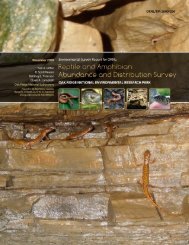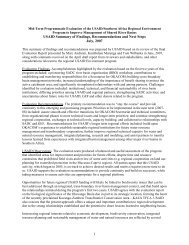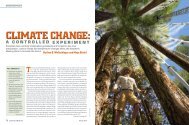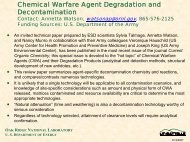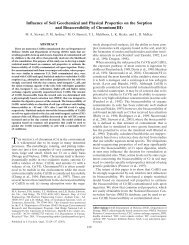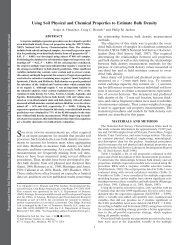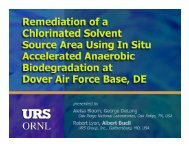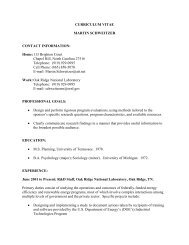oak ridge reservation physical characteristics and natural resources
oak ridge reservation physical characteristics and natural resources
oak ridge reservation physical characteristics and natural resources
You also want an ePaper? Increase the reach of your titles
YUMPU automatically turns print PDFs into web optimized ePapers that Google loves.
Recharge of the groundwater system is strongly seasonal at the ORR, <strong>and</strong> percolation processes<br />
in the shallow soil are moderated by the amount of soil moisture present. During the active growing<br />
season (April through October) evapotranspiration by plants removes moisture from the soil within<br />
the root zone. When soil moisture levels are low, any percolating rainwater is absorbed in the root<br />
zone to replenish the soil moisture deficit. During that phase little or no water reaches the water table.<br />
When rainfall amounts exceed any existing soil moisture deficits <strong>and</strong> saturation of the shallow<br />
soils begins to occur, seepage of water begins. When saturation of the shallow soils occurs on sloping<br />
l<strong>and</strong>, the downslope gradient allows lateral drainage of water through macropores (e.g., holes left by<br />
decay of dead plant roots, animal burrows) as well as vertical seepage to the water table through<br />
pervious zones. During the nongrowing season (November through March), there is little<br />
evapotranspiration to remove water from the root zone, <strong>and</strong> saturation of the shallow soils occurs<br />
more rapidly than during the summer months. Typical evapotranspiration losses from the root zone<br />
range from a low of about 0.01 in./d (0.025 cm/d) rainfall equivalent during January <strong>and</strong> February to<br />
a high of about 0.16 in./d (0.41 cm/d) rainfall equivalent during July. Thus, development of a 1-in.<br />
(2.5-cm) water deficit would require only 1 week without rainfall during July but more than 2 months<br />
without rainfall during the winter.<br />
The amount of water that actually recharges the groundwater zone is highly variable across the<br />
ORR, depending on the shallow soil <strong>characteristics</strong>, permeability <strong>and</strong> degree of fracturing of regolith<br />
(rocky, weathered in place) beneath the surface soils, presence of dolines that capture storm flow <strong>and</strong><br />
focus recharge in small areas, <strong>and</strong> presence of paved or covered areas in which little or no rainfall<br />
infiltration occurs. Higher recharge is expected in areas of karst hydrogeology such as the Knox<br />
Aquifer because of internal drainage through dolines than in areas underlain by the clastic bedrock<br />
formations.<br />
6.3 SATURATED ZONE HYDROLOGY<br />
The saturated zone on the ORR can be conceptually divided into four flow zones in a vertical<br />
cross section: (1) an uppermost water-table interval, (2) an intermediate interval, (3) a deep interval,<br />
<strong>and</strong> (4) an aquiclude (i.e., a zone of extremely low permeability). The presence <strong>and</strong> thickness of any<br />
zone can vary across the ORR. Available evidence indicates that most water in the saturated zone<br />
(i.e., the water table to the intermediate interface) in the ORR Aquitards is transmitted through a 3- to<br />
20-ft (1- to 6-m) layer of closely spaced, well-connected fractures. The water table is a surface that<br />
defines the upper limit of saturation.<br />
As in the storm-flow zone, the bulk of groundwater in the saturated zone resides within the pore<br />
spaces of the rock matrix. The rock matrix typically forms blocks that are bounded by fractures.<br />
Contaminants migrating from sources by way of the fractures typically occur in higher concentrations<br />
than in the matrix; thus, the contaminants tend to move (diffuse) into the matrix. This process, termed<br />
diffusive exchange or matrix diffusion, between water in matrix pores <strong>and</strong> water in adjacent fractures<br />
reduces the overall contaminant migration rates relative to groundwater-flow velocities. For example,<br />
the leading edge of a geochemically nonreactive contaminant mass such as tritium might migrate<br />
along fractures at a typical rate of 3 ft/d (1 m/d); however, the center of mass of a contaminant plume<br />
typically migrates at a rate less than 2 ft/d (0.66 m/d).<br />
In the ORR Aquitards, chemical <strong>characteristics</strong> of groundwater change from a mixed-cation-<br />
HCO 3 water type at shallow depth to an Na-HCO 3 water type at deeper levels (100 ft [30.5 m]). This<br />
transition, not marked by a distinct change in rock properties, serves as a useful marker <strong>and</strong> can be<br />
used to distinguish the more active water table <strong>and</strong> intermediate groundwater intervals from the<br />
sluggish flow of the deep interval. There is no evidence of similar change with depth in the chemical<br />
<strong>characteristics</strong> of water in the Knox Aquifer; virtually all wells are within the monitoring regime of<br />
Ca-Mg-HCO 3 -type water. Although the mechanism responsible for this change in water types is<br />
poorly understood, it most likely is related to the amount of time the water is in contact with a<br />
specific type of rock.<br />
15




